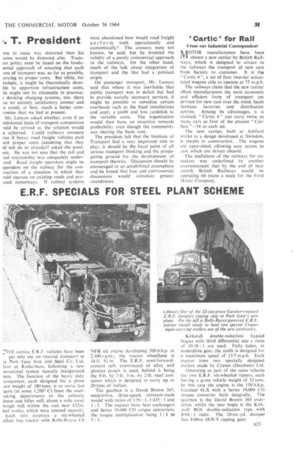1. T. President 'ere in some way distorted then his
Page 57

If you've noticed an error in this article please click here to report it so we can fix it.
-mice would be distorted also. Transort policy must be based on the fundaiental approach of ensuring that each )rm of transport was, so far as possible, trrying its proper costs. But while, for xample, it might be theoretically desirble to apportion infrastructure costs, us might not be attainable in practice; t devising charging systems, too, there as no entirely satisfactory answer and 'e could, at best, reach a better cornromise than we had at present.
Mr. Lemass asked whether, even if an ndistorted basis of transport competition auld be arrived at, the solution would e achieved. Could railways compete ten if heavy road freight vehicles paid teir proper costs (assuming that they id not do so already)? asked the presient. He was not sure that the rail and 3ad relationship was adequately underood. Road freight operators might be ependent on the railway for the connuation of a situation in which they Duld operate on existing roads and proicted motorways. If railway systems
were abandoned how would road freight perform both operationally and economically? The answers were not known, he said; but he doubted the validity of a purely commercial approach to the railways. On the other hand, much of the talk about integration of transport and the like had a political origin.
On passenger transport, Mr. Lemass said that where it was inevitable that public transport was in deficit but had to provide socially necessary services, it might be possible to subsidize certain overheads such as the fixed installations and apply a profit and loss yardstick to the variable costs. The organization would then have an incentive towards profitability even though the community was sharing the basic cost.
The president felt that the Institute of Transport had a very important role to play; it should be the focal point of all serious transport thinking and the propagating ground for the development of transport theories. Discussion should be encouraged in an uninhibited atmosphere and he hoped that free and controversial discussions would stimulate greater attendances.
Cartic for Rail
From our Industrial Correspondent
MOTOR manufacturers have been shown a new carrier by British Railways, which is designed to attract to the railways the transport of new cars from factory to customer. It is the " Cartic 4 ", a set of 'four two-tier articulated wagons able to operate at 75 m.p.h, The railways claim that the new carrier offers manufacturers the most economic and efficient form of transport yet devised for new cars over the trunk hauls between factories and distribution centres. Among its advantages, it is claimed, "Cartic 4" can carry twice as many cars as four of the present Carflats --34 to each set.
The new carrier, built at Ashford works to a design developed at Swindon, is simple in construction. The wagons are open-sided, allowing easy access to cars which are driven aboard.
The usefulness of the railways for car makers was underlined by another announcement that by the end of next month British Railways would be operating 60 trains a week for the Ford Motor Company.




































































































































